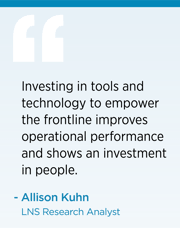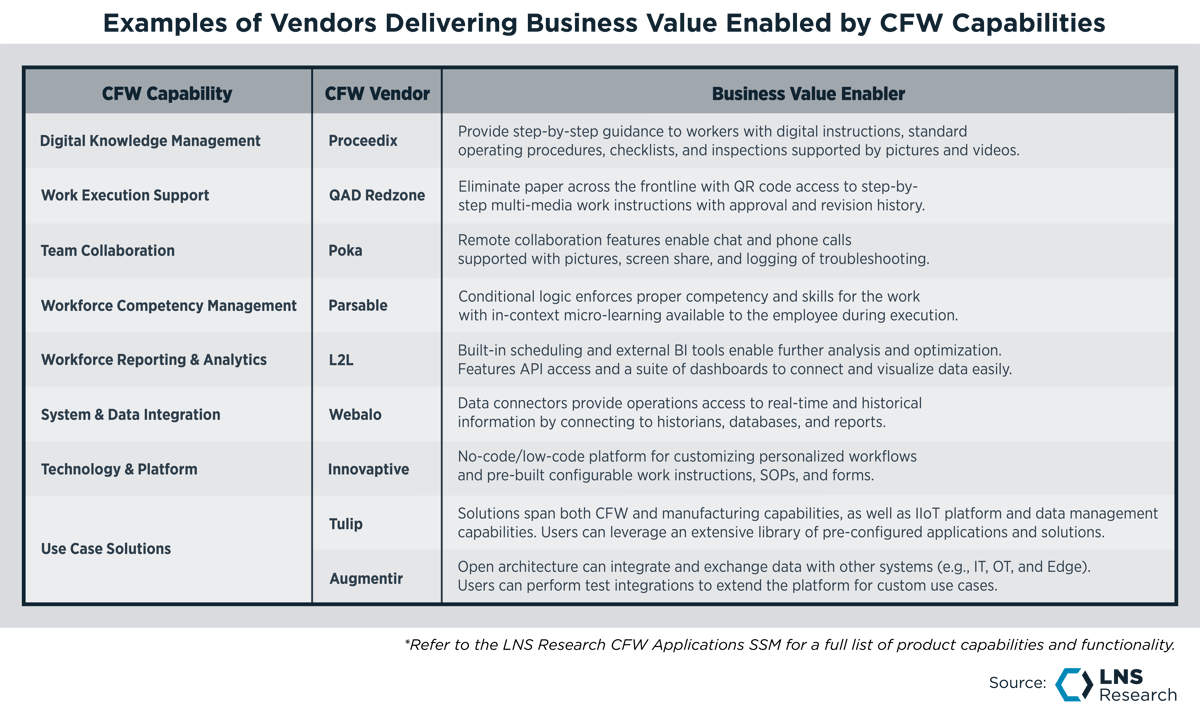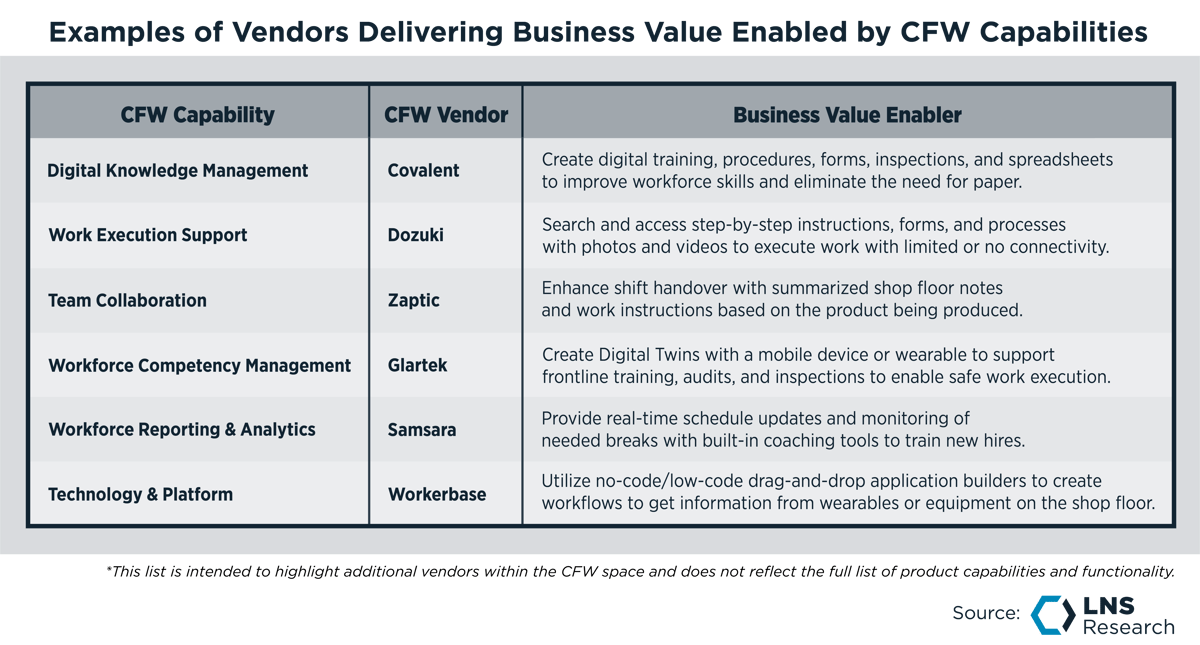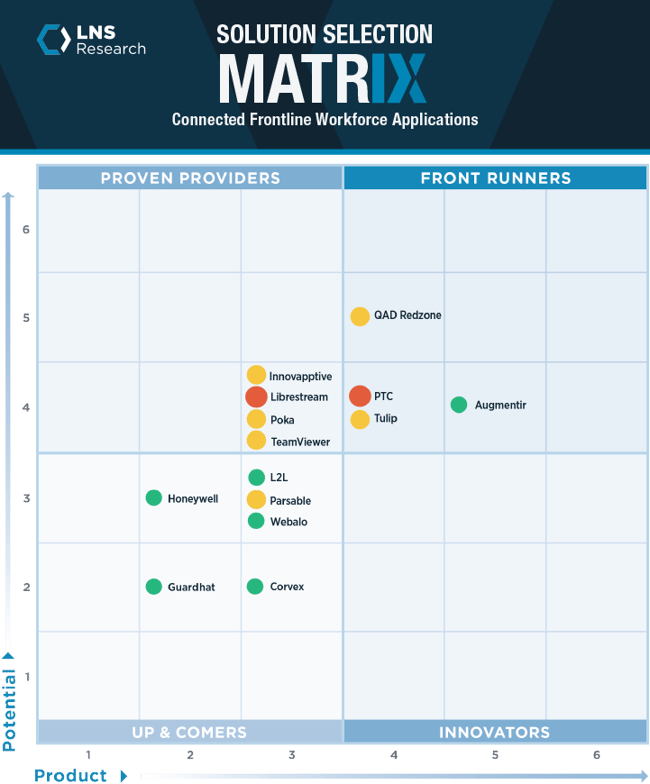The Connected Frontline Workforce (CFW) applications space is diverse, dynamic, and fragmented. Players range from early-stage start-ups backed by venture capital to publicly traded global tech giants. The vendors in this space offer a wide range of products and go-to-market strategies.
%20Applications%20to%20Future-proof%20the%20Frontline%20Workforce.png?width=300&height=283&name=Connected%20Frontline%20Workforce%20(CFW)%20Applications%20to%20Future-proof%20the%20Frontline%20Workforce.png) CFW initiatives have become a strategic imperative for many as manufacturers seek to solve critical labor shortages, skills gaps, and retention issues in frontline operations. CFW-enabling technology has been proven to help companies meet frontline workforce challenges while optimizing operational performance across safety, quality, and productivity dimensions. However, navigating the relatively immature and highly fragmented CFW Applications market to capture the opportunity fully can be challenging.
CFW initiatives have become a strategic imperative for many as manufacturers seek to solve critical labor shortages, skills gaps, and retention issues in frontline operations. CFW-enabling technology has been proven to help companies meet frontline workforce challenges while optimizing operational performance across safety, quality, and productivity dimensions. However, navigating the relatively immature and highly fragmented CFW Applications market to capture the opportunity fully can be challenging.
The vendors included in the LNS Research Solution Selection Matrix (SSM) are aligned to four main categories: AR-centric, CFW Specialists, Industrial Software, and Operations Collaboration and Execution platforms. No bright lines separate these categories, with the capabilities and enabling technology across them continuing to grow and converge. The diversity of vendors continues to expand as the market evolves rapidly.
This blog gives manufacturing leaders a deeper understanding of the Operations Collaboration and Execution Platforms within the Connected Frontline Workforce market.
Growing Adoption of CFW Technology
 Evolving workforce dynamics and a poor economic climate have led to
Evolving workforce dynamics and a poor economic climate have led to
manufacturing facing challenges never seen before. The inability to engage and retain frontline workers has caused over 70% of industrial organizations to see negative impacts on operational performance. A rapid decline in safety, quality, and productivity highlights a strong need for change to protect business continuity.
Organizations investing in workforce connectivity and collaboration have achieved true business value. As the burning platform across the frontline became clear, manufacturers turned to technology to digitally connect and enable the frontline. The CFW market began to emerge as industrials adopted software applications designed for and used by the frontline.
 The value Connected Frontline Workforce solutions have enabled has increased as capabilities matured to provide more personalized and in-context insights. As labor shortages, skills gaps, and retention issues steadily worsen, manufacturers are rapidly accelerating their plans to adopt CFW technology. With frontline workers making up nearly 80% of the workforce, there is a strong demand for solutions that meet the needs of this historically underserved market.
The value Connected Frontline Workforce solutions have enabled has increased as capabilities matured to provide more personalized and in-context insights. As labor shortages, skills gaps, and retention issues steadily worsen, manufacturers are rapidly accelerating their plans to adopt CFW technology. With frontline workers making up nearly 80% of the workforce, there is a strong demand for solutions that meet the needs of this historically underserved market.
Shifting from Point Solutions to CFW Capabilities
Today's challenging environment and fast pace of operations require agility across the value chain. Manufacturers need to build a customer-focused organization. To do that, the business must improve the interaction between functional groups.
Point solutions deployed in the past have typically solved a single problem or met a specific need. However, maintaining the number of individual solutions in place is often difficult, and it can be taxing on the infrastructure. Still, many organizations find it hard to justify walking away from the time and effort spent on existing solutions.
Operations Collaboration and Execution Platforms are CFW applications with key capabilities that enable use cases across the value chain. Often, these solutions meet multiple needs and provide more capabilities to enable cross-functional work execution and collaboration. The value gained from breaking down functional silos has made the business case much more attractive for manufacturers.
Achieving Business Value with CFW Capabilities
Increasing workforce connectivity has been proven to increase business value significantly. The LNS Research Solution Selection Matrix (SSM) has identified Connected Frontline Workforce solutions that demonstrate the ability to deliver on the vendor's value proposition. Operations Collaboration and Execution Platforms specifically align cross-functional groups to the work that needs to be done and shared goals to improve profitability. %20Applications%20Key%20Capabilities.png?width=1200&height=866&name=Connected%20Frontline%20Workforce%20(CFW)%20Applications%20Key%20Capabilities.png)
When evaluating CFW applications, eight vendor solutions substantially fit our inclusion criteria for this major sub-category: Augmentir, Innovapptive, L2L, Parsable, Poka, QAD Redzone, Tulip, and Webalo. Each of these platforms demonstrates the ability to displace point solutions across industry verticals and deliver tangible business value. The CFW Applications SSM Vendor Compendium contains a detailed analysis and commentary on each provider.
Manufacturers are rapidly deploying CFW Operations Collaboration and Execution Platforms across the enterprise to realize significant business value. There is no shortage of offerings within the market landscape that aims to fill this need, including the two vendors highlighted in the CFW Applications Guidebook: Dozuki and Proceedix. The table below illustrates how manufacturers partner with vendors to deploy CFW key capabilities to unlock business value: 
Continued Growth of the CFW Market
 The rapid adoption of CFW applications across manufacturing is driving a significant uptick in the number of vendors marketing connected workforce solutions. Industrial organizations must focus on finding solutions that do more than just provide data and information to empower the frontline. Operations Collaboration and Execution Platforms are an excellent way for manufacturers to improve workforce connectivity, drive continuous improvement, and enable a Unified Performance Excellence (UPX) culture.
The rapid adoption of CFW applications across manufacturing is driving a significant uptick in the number of vendors marketing connected workforce solutions. Industrial organizations must focus on finding solutions that do more than just provide data and information to empower the frontline. Operations Collaboration and Execution Platforms are an excellent way for manufacturers to improve workforce connectivity, drive continuous improvement, and enable a Unified Performance Excellence (UPX) culture.
Many vendors previously not included in the LNS Research CFW Solution Selection Matrix published in 2023 could be included in an updated version. These product offerings deliver on the vendor's value proposition by deploying solutions across a wide range of use cases to align cross-functional groups and improve profitability. The below table continues to illustrate the business value CFW capabilities enable and additional vendors manufacturers should consider when evaluating solutions to digitally enable the workforce: 
The diversity of vendor maturity, wide range of solutions, and continued M&A reflect an early technology market's fragmented and dynamic nature. Manufacturers should expect continued growth as CFW solutions prove strong business value. Industrial software providers haven't yet gained traction in this important new space, but we anticipate these not-so-agile giants will pivot sooner rather than later within the year.
Final Thoughts
 CFW applications that use advanced technology to provide the frontline with meaningful and differentiated value are a strategic imperative to a future-proof frontline workforce. Manufacturing continues to face the challenges associated with a declining labor pool and the shortage of skilled labor. Newer generations will continue to demand innovative technology from employers.
CFW applications that use advanced technology to provide the frontline with meaningful and differentiated value are a strategic imperative to a future-proof frontline workforce. Manufacturing continues to face the challenges associated with a declining labor pool and the shortage of skilled labor. Newer generations will continue to demand innovative technology from employers.
Adopters of CFW technology have been able to bridge the skills gap while significantly improving employee attraction, training, and retention. Industrial organizations must look to partner with a vendor who provides a more comprehensive solution and understands the manufacturing challenges ahead. The CFW market is changing fast, and there is no one-size-fits-all solution.
The LNS Research CFW SSM is the definitive resource for defining, evaluating, and choosing the right CFW application for your organization. We expect more players to enter the CFW solution space as business value climbs exponentially. Stay tuned for future blogs highlighting how manufacturers are solving critical labor shortages, skills gaps, and retention issues in frontline operations with CFW solutions.
